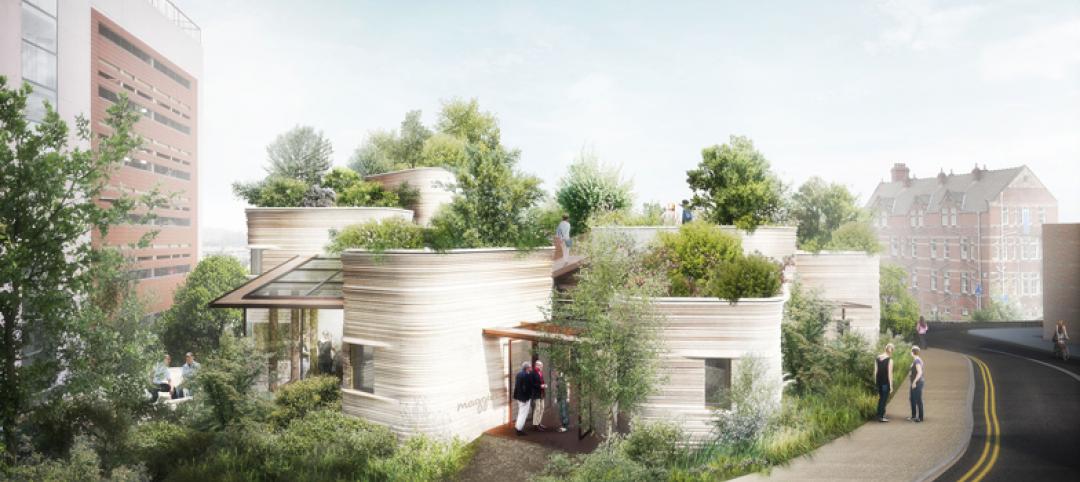Over the past few decades, numerous research studies have concluded that noise in hospitals can have a deleterious effect on patient care and recovery. “The first step in noise reduction in hospitals is awareness about the effect that noise has on patients and providers,” says Paul Barach, MD, Clinical Professor, Wayne State University, Detroit.
Barach cites studies that estimate average hospital noise at 70–80 decibels, or 20–30 db above World Health Organization recommended levels. Older hospitals have even worse acoustics. Barach also suggests that noise in general is an “abstraction” that even newer hospitals find difficult to define and mitigate.
Noise control is even more important now that the Affordable Care Act has mandated that reimbursement for hospital services be based, in part, on patient satisfaction surveys. These surveys have consistently given the lowest scores to hospital environments for sleep disruption. It’s little wonder, then, that hospitals are pursuing more quietude in their plans for new buildings, renovations and expansions, as well as in their personnel training.
“Acoustics is invisible until it’s a problem,” observes James Perry, Chief Technology Officer for the New York-based acoustical and A/V consultant Cerami & Associates. He emphasizes, too, that noise “is about behavior,” and often is generated “by activities [more] than building systems.”
Different rooms, different noises
Noise abatement strategies need to take into account that hospitals have many rooms with different noise characteristics, says Ben Davenny, PE, INCE, LEED AP EDAC, a Senior Acoustical Consultant with Acentech. Patient floors are usually organized around bustling nurses’ stations. MRI rooms are particularly sensitive to vibration through floors and walls. Operating rooms require 20 air exchanges per hour, creating their own unique din.
There are lobbies, waiting rooms, examination and emergency rooms where privacy is paramount. Many larger, regional hospitals have helipads: their chopper noise must be kept from entering the building.
Davenny points out that it is useful to consider the type of noise source. “There’s a false impression that a quieter environment is always a better one,” he says. “The trick is to take a different look at these noise sources and develop more efficient methods in reducing disturbance to patients.”
Medical technology has become a new noise source that has “overwhelmed” the hospital environment, says Joanne Solet, PhD, Assistant Clinical Professor of Medicine at Harvard Medical School. Solet was part of a team of researchers that conducted a three-day study in which the team subjected 12 healthy participants to 14 different sounds to determine which sounds were most likely to disrupt sleep.
The team’s findings, published in the Annals of Internal Medicine (June 2012), found that “electronic sounds” were more arousing than others. “If these noises bothered a dozen healthy people, you can bet they are bothering people who are patients,” says Solet.
Over the din, patients are heard
Noise reduction started showing up on hospitals’ radar screens in 2006, when the Centers for Medicare & Medicaid Services (CMS) implemented an ongoing national survey—known as the Hospital Consumer Assessment of Healthcare Providers and Systems, or HCAHCP—to measure customer satisfaction with hospital care. When the Affordable Care Act became law, it included a requirement that the survey results be used as one measure to calculate payments that CMS made to acute-care hospitals.
“The surveys let consumers weigh in, and with HCAHCP, hospitals can’t bury their issues,” says David Sykes, Chairman of the Acoustics Research Council.
From July 1, 2013 through June 30, 2014, the latest period tracked and posted by Medicare.gov, 62% of patients surveyed said their rooms were “always quiet at night,” with another 29% saying their rooms were “usually quiet.” Those scores were below patient ratings for 30 other criteria of their hospital stay, such as cleanliness and communications.
With one in three hospitals operating in the red, according to the American Hospital Association, patient satisfaction has become a make or break issue. The poorest-performing hospitals have 1% of their total annual reimbursements withheld by CMS; the highest-performing facilities get a 1% bonus. By 2017, those fines and bonuses will increase to 2%.
“Hospitals need to know how much quiet a patient needs to be able to sleep because they’re getting dinged by the government if their performance scores are low,” says Gary Madaras, PhD, Associate AIA, ASA, INCE, an Acoustics Specialist with Rockfon, which makes acoustic ceiling products. Solet adds that the government now bases its acceptance levels for patient readmission to hospitals in part on the facility’s past performance.
Healthcare systems are addressing this problem by getting more stakeholders involved in helping them improve patient satisfaction. HGA Architects and Affinity Health solicited input from former patients, family members, and caregivers during pre-design sessions for Affinity’s 25,000-sf Heart, Lung, and Vascular Center at St. Elizabeth Hospital, in Appleton, Wis. Those sessions included discussions about workflow, corridor circulation patterns, and patient privacy. The team also implemented a post-occupancy evaluation determine whether its evidence-based design principles were being achieved in areas that include noise levels.
For several years now, architects have been turning to the Facilities Guidelines Institute’s guidelines for product and design best practices that can help their clients tone down noise and vibration. “We provide the tools to build the better mousetrap,” says FGI CEO Douglas Erickson, FASHE, CHFM, HFDP, CHC.
Stanford Health Care, Palo Alto, Calif., is building an 824,000-sf, 368-bed hospital that is following many of the noise and vibration reduction guidelines laid out by the FGI, says George Tingwald, MD, AIA, ACHA, Director of Medical Planning, Facilities Design and Construction at Stanford Health.
Hospitals are also trying to get their employees to be more alert to the noise they produce. Bonny Slater, Senior Interior Designer-Health & Wellness in Gensler’s Washington, D.C., office, sees hospitals experimenting with “quiet times,” when corridor lights are dimmed to signal when noise volumes should be lowered.
Reactions to noise are subjective
Not everyone is convinced that design can alter staff behaviors to reduce hospital noise, especially when a lot of hospitals still don’t coordinate when clinical, food service, and cleaning staffs enter a patient’s room, says Kenneth Van Wyk, President of consultant Acoustics by Design. “There are no dashboards in hospitals,” says Sykes. Chris Kay, ACHE, Managing Principal-National Healthcare & Science Buildings Practice at Jacobs, is even less sanguine about behavioral modification, which he calls “the least effective method of reducing hospital noise.”
Patient surveys have certainly given hospitals more insight into where their services and facilities are falling short or excelling. Jean R. Elrick, MD, Senior Vice President of Administration at Massachusetts General Hospital, in Boston, gets patient narratives every Wednesday. She says she can tell which buildings and departments are performing best. Mass General’s 530,000-sf Lunder Building, which opened in 2011, was among a handful of hospital facilities that closely followed FGI’s 2010 revised guidelines. Elrick says Lunder’s patient scores have consistently risen, and Lunder has become the model the hospital would follow when it renovates or expands other buildings on its campus.
The 640,000-sf MaineGeneral Medical Alfond Center for Health, in Augusta, which opened in August 2013, is another replacement hospital that was built to FGI’s noise and vibration guidelines. As a result, its “always quiet at night” score improved to 76.5% over the period December 2013 through July 2014, from 61.5% over the period January through October 2013. The portion of patients who would recommend the hospital jumped to 76.8%, from 65.2%, according to Rick Albert, MaineGeneral’s Director of Plant Operations.
But patient scores don’t tell the whole story, mainly because surveys don’t identify which noises are causing the most distress. Since 2010, Rockfon’s Madaras has tracked patient scores of about 50 new hospitals. He has found that most new faciliies aren’t that much better than older ones. Those findings lead Madaras to believe that reactions to hospital noises can be individual and subjective.
Solet points out that a certain portion of the population is always going to be more sensitive to their surroundings. So, says Tingwell of Stanford Health Care, a hospital’s biggest dilemma, when devising a noise-reduction strategy, might be figuring out how to assuage patients’ perceptions, real or imagined, about noise.
Related Stories
Healthcare Facilities | Jul 8, 2015
From Subway to Walgreens, healthcare campuses embrace retail chains in the name of patient convenience
Most retail in healthcare discussions today are focused on integrating ambulatory care into traditional retail settings. Another trend that is not as well noted is the migration of retailers onto acute care campuses, writes CBRE Healthcare's Craig Beam.
University Buildings | Jun 29, 2015
Ensuring today’s medical education facilities fit tomorrow’s healthcare
Through thought-leading design, medical schools have the unique opportunity to meet the needs of today’s medical students and more fully prepare them for their future healthcare careers. Perkins+Will’s Heidi Costello offers five key design factors to improve and influence medical education.
Sponsored | Healthcare Facilities | Jun 23, 2015
Texas eye surgery center captures attention in commercial neighborhood
The team wanted to build an eye surgery center in an already established area but provide something clean and fresh compared to neighboring buildings.
Healthcare Facilities | Jun 16, 2015
Heatherwick’s design for cancer center branch has ‘healing power’
The architect describes it as “a collection of stepped planter elements”
Healthcare Facilities | May 27, 2015
Roadmap for creating an effective sustainability program in healthcare environments
With a constant drive for operational efficiencies and reduction of costs under an outcome-based healthcare environment, there are increasing pressures to ensure that sustainability initiatives are not only cost effective, but socially and environmentally responsible. CBRE's Dyann Hamilton offers tips on establishing a strong program.
Healthcare Facilities | May 27, 2015
Rochester, Minn., looks to escape Twin Cities’ shadow with $6.5 billion biotech development
The 20-year plan would also be a boon to Mayo Clinic, this city’s best-known address.
Healthcare Facilities | Apr 28, 2015
10 things about Ebola from Eagleson Institute's infectious disease colloquium
Research institutions know how to handle life-threatening, highly contagious diseases like Ebola in the lab, but how do we handle them in healthcare settings?
Green | Apr 22, 2015
AIA Committee on the Environment recognizes Top 10 Green Projects
Seattle's Bullitt Center and the University Center at The New School are among AIA's top 10 green buildings for 2015.
Building Team Awards | Apr 10, 2015
14 projects that push AEC teaming to the limits
From Lean construction to tri-party IPD to advanced BIM/VDC coordination, these 14 Building Teams demonstrate the power of collaboration in delivering award-winning buildings. These are the 2015 Building Team Award winners.
Building Team Awards | Apr 10, 2015
Prefab saves the day for Denver hospital
Mortenson Construction and its partners completed the 831,000-sf, $623 million Saint Joseph Hospital well before the January 1, 2015, deadline, thanks largely to their extensive use of offsite prefabrication.

















